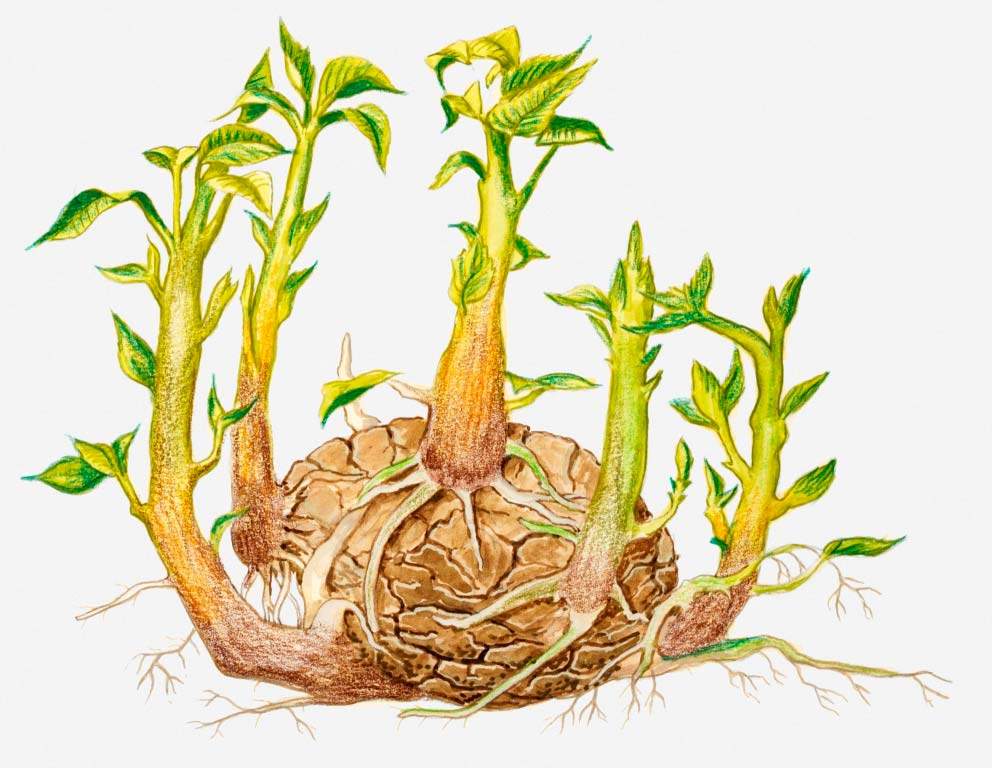In 1924, Science magazine reported on a fatal case of potato poisoning: James B. Matheney of Vandalia, Illinois, had gathered about one and a half bushels of tubers, which had turned green due to sunlight exposure. Two days after eating the potatoes, most of his family – wife, two daughters and four sons – showed symptoms of poisoning; the only exceptions were James himself, who didn’t eat the potatoes, and a breast-fed baby boy. His wife, aged 45, died a week later, followed by their 16-year-old daughter. The other five members of the family recovered.
Although such fatalities are rare among human beings, farm animals often get sick or die after eating green potatoes. Symptoms include damage to the digestive system as well as loss of sensation, hallucinations and other neurological disturbances. Death can be caused by a disruption of the heart beat. The culprits are the toxic substances solanine and chaconine; their concentration rises sharply with exposure to light or during sprouting, and they protect the tubers from insects and disease.
Solanine and chaconine belong to the large family of glycoalkaloids, which includes thousands of toxins found in small amounts in other edible plants, including tomatoes and eggplant. These substances have been known for over 200 years, but only recently has
Prof. Asaph Aharoni of the Plant Sciences Department begun to unravel how they are produced in plants. He and his team have mapped out the biochemical pathway responsible for manufacturing glycoalkaloids from cholesterol. Their findings will facilitate the breeding of toxin-free crops and the development of new crop varieties from wild strains that contain such large amounts of glycoalkaloids, they are currently considered inedible. On the other hand, causing plants to produce glycoalkaloids if they don’t do so naturally or increasing their glycoalkaloid content can help protect them against disease.
Two years ago, in research reported in
The Plant Cell, the scientists identified the first gene in the chain of reactions that leads to the production of glycoalkaloids.
In a new study published recently in
Science, they have now managed to identify nine other genes in the chain by using the original gene as a marker and comparing gene expression patterns in different parts of tomatoes and potatoes. Disrupting the activity of one of these genes, they found, prevented the accumulation of glycoalkaloids in potato tubers and tomatoes. The team then revealed the function of each of the genes and outlined the entire pathway, consisting of ten stages, in which cholesterol molecules turn into glycoalkaloids.
An analysis of the findings produced an intriguing insight: Most of the genes involved are grouped on chromosome 7 of the potato and tomato genome. Such grouping apparently prevents the plants from passing on to their offspring an incomplete glycoalkaloid pathway, which can result in the manufacture of chemicals harmful to the plants.
The research was conducted by postdoctoral fellow Dr. Maxim Itkin, who worked with Dr. Uwe Heinig, Dr. Oren Tzfadia, Pablo D. Cardenas, Dr. Samuel Bocobza, Dr. Sergey Malitsky and Dr. Ilana Rogachev of Prof. Aharoni’s lab; as well as Dr. Tamar Unger of the Israel Structural Proteomics Center at the Weizmann Institute, and scientists from the National Chemical Laboratory in Pune, India, the Hebrew University of Jerusalem and the Wageningen University, the Netherlands.
Prof. Asaph Aharoni's research is supported by the Clore Center for Biological Physics; the Kahn Family Research Center for Systems Biology of the Human Cell; the Tom and Sondra Rykoff Family Foundation; Roberto and Renata Ruhman, Brazil; the Adelis Foundation; the Leona M. and Harry B. Helmsley Charitable Trust; the Minna James Heineman Stiftung; and the Raymond Burton Plant Genome Research Fund. Prof. Aharoni is the incumbent of the Peter J. Cohn Professorial Chair.
